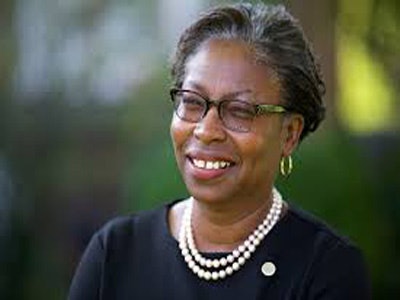WASHINGTON — At a time when calls to align higher education with workforce needs are ubiquitous, Tuajuanda Jordan — president at St. Mary’s College of Maryland — bucked the trend Wednesday and questioned the merits of “training for the immediately apparent and educating for an uncertain future.”
“We keep talking about ‘education must be aligned with workforce needs,’ but who is setting the vision as to what the workforce needs are going to be in the future?” Jordan asked.
 St. Mary’s College President Tuajuanda Jordan
St. Mary’s College President Tuajuanda JordanJordan said if students are guided down certain educational paths in order to meet workforce demands, policymakers and educational leaders must make sure the system is sustainable and that workers can get retrained without having to incur a lot of additional costs.
“You can’t just train for an immediate job and we know in the next few years it’s going to go away and the people are left with a skill that’s unusable,” Jordan said. “The system should be if we guide you down this path and jobs go away where you can’t function anymore, we will retrain you for something else.”
Jordan made her remarks Wednesday at the National Press Club during the release of “Investing in the Future: Sharing Responsibility for Higher Education Attainment,” the capstone report of the National Commission on Financing 21st Century Higher Education. The commission — which has produced 10 white papers on a range of higher education issues — was created by the University of Virginia Miller Center.
The final report draws from all those papers and makes a series of recommendations that Brian Fitzgerald, CEO of the Business-Higher Education Forum, described a “full menu of strategies that we all have to advance.”
Fitzgerald pressed for better information to match graduates with jobs.
“If we don’t do a better job of informing students and families where the jobs are at all levels, from certificates to bachelor’s or master’s degrees, and be very clear about what the relative skill levels are, and what sectors are growing versus which are not, I don’t think we can ever restore confidence in higher education to provide a future for Americans young or old,” Fitzgerald said.
Fitzgerald echoed a recommendation of the report to make better information “available to all students and parents when choosing degree programs and schools.”
“Information should include the cost of attaining a credential or degree from various institutions available in the region and the potential wage value of different credentials,” the report states. “A major reason some students default on college debt is because they choose careers that do not adequately compensate them for the cost of attending college.”
The report also calls for states to “stimulate the development and implementation of low-cost education delivery models.”
“That’s fine, especially for certain groups of people,” Jordan said. “But if you look at underrepresented students, students who are first generation in college, oftentimes they do better when they’re involved in something that is a high impact practice. Those things are expensive, even though they increase graduation and retention rates.”
High-impact practices at St. Mary’s include first-year seminars, learning communities, collaborative projects, undergraduate research, service learning, internships, study abroad, and senior capstone courses, according to the St. Mary’s 2016-2019 strategic plan and a 2016 budget document.
Not all of the recommendations made in the report released Wednesday are universally accepted. For instance, in its call to “encourage productivity in the postsecondary system,” the report says states should employ outcomes-based funding, or OBF, formulas when distributing institutional aid so that more resources go to colleges and universities that increase productivity.
“Despite the compelling logic behind paying for performance in higher education, research comparing states that have and have not adopted the practice has yet to establish a connection between the policy and improved educational outcomes,” states a recent paper from The Century Foundation, that points out universities in Indiana, which has adopted OFB, have become “more selective and less diverse.”
Quarrels with the recommendations of the Miller Center’s latest higher education report aside, Jordan said the paper will help higher education leaders and policymakers focus on how to deliver education to groups who “represent the change demographic of America.” Doing so, she said, will lead to outcomes that transcend higher earnings.
“When you think about society, when you think about people who are highly educated, they are more civically engaged,” Jordan said. “They want to do more for people and they want to increase their philanthropy, not just because they have the money but because they see the need.”
Jamaal Abdul-Alim can be reached at [email protected]. You can follow him on Twitter @dcwriter360.


















